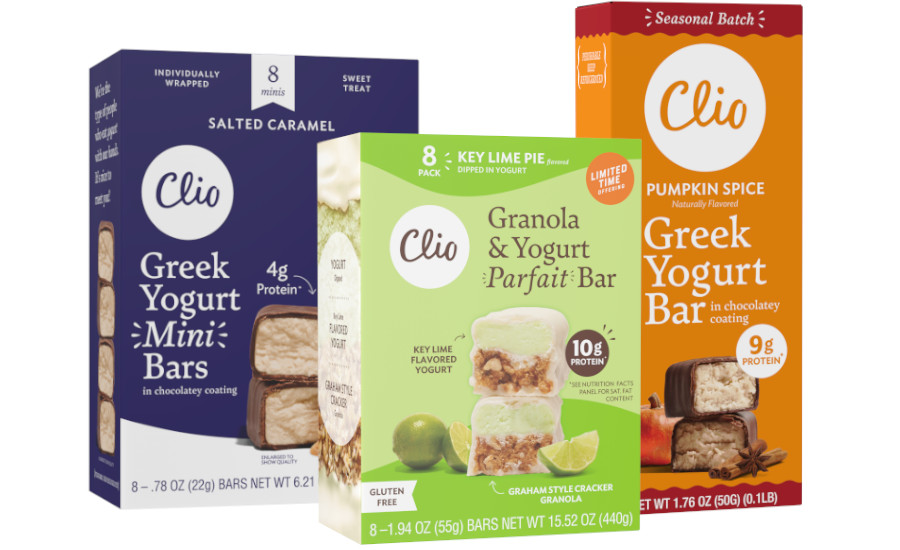With a new football season under way, fans of the Chicago Bears are cautiously optimistic. There’s a new general manager, Ryan Poles, a first-time head coach in Matt Eberflus and quarterback Justin Fields’ rookie season is behind him. Even the first-round draft pick, with a collapsing offensive line and limited offensive weapons, can’t solely be blamed for the Bears’ 6-11 third-place finish (out of four teams) in the NFC North in 2021.
“You win and lose as a team” is an often-quoted idiom that also is applicable to the “teamwork” involved in bringing a new dairy product to fruition.
Just as an NFL team researches its opponent, maps out plays, and regularly practices formations so they can win on game day, new product development (NPD) employs similar steps on the formulation journey to success. This involves researching and anticipating future trends, coming up with a great idea, establishing supplier partnerships, locking in base formulations, executing pilot plant trials, refining the product concept, confirming packaging and labeling, finalizing marketing and advertising, and, finally, commercializing the product.
But exactly how long does that take from concept to completion? John McGuckin, CEO of Clio Snacks, the makers of refrigerated creamy Greek yogurt bars wrapped in a coating of chocolate, estimates that, after feasibility approvals, it can take anywhere from 24 to 36 weeks before a new product appears on shelf.
“At Clio Snacks, we follow a strict innovation project pipeline from ideation through feasibility, execution, and post-launch review,” McGuckin notes. “…Retailers, in general, require a 12-week lead time from presentation to first shipment — assuming they approve the product. Therefore, we need to be fully confident in the launch for samples and presentations three months prior to the customer’s first ship date. Innovation is part of our daily processes and workflow.”
NPD also plays a key role at Butter Buds Inc., a Racine, Wis.-based ingredient supplier that produces fat and cholesterol-free concentrated butter-flavored granules as an economical alternative to butter, margarine, or oil.
“It [NPD] reinforces our commitment to keep our customers informed of current market trends, what’s available, and what direction we anticipate future trends,” explains Mike Ivey, Butter Buds’ national sales director. “I would say our [research and development] (R&D) department devotes at least 70% of their time to new product development.”
Taking that all-important lightbulb idea and getting it into the dairy marketplace varies based on complexity, but Ivey estimates the average timeline is between 12 to 16 weeks.
Portland, Ore.-based Icon Foods prides itself on its solutions-driven approach in helping dairy processors find the right dairy and nondairy solutions with one key best practice in mind: innovation.
“Innovation is our leading differential competitive advantage. In my role as CEO and Chief Food Scientist at Icon Foods, 90% of my time is within the scope of innovation,” says Thom King. “From concept to protocept to launch usually takes about six months.
“At Icon Foods, we use a standard process that I learned at Cornell. We start with a needs analysis which includes identifying a category and demographic,” King continues. “We then start building a protocept model and present it to the customer to make sure we are going in the right direction. We then move to creating a prototype which is also presented to the customer. Then requests and changes are put into place. This typically repeats three to four times. We then place this with the best co-packer.”

Testing for success
While R&D expertise and access to an Applications Lab is “extremely valuable” to the NPD process, it isn’t required, according to Derek Holthaus, director of innovation and solutions at FlavorSum, Kalamazoo, Mich.
Yet, a dedicated team of developers and a lab to conduct new product development will improve speed to market and help dairy manufacturers maintain control over intellectual property and ingredients used in the formulation, he maintains.
However, options are available for companies that do not have internal capabilities for NPD. “Companies can leverage third-party consulting groups or ingredient vendors with these capabilities to assist in new product development from concept to commercialization,” he explains.
Butter Buds’ Ivey surmises that the combination of R&D and applications groups that can collaborate well together in NPD is critical.
“Creating new ingredients then testing those ingredients in real-world applications is key,” he says, noting that even with lots of trial and error and several ideations before plant trials, there’s only about a 10-15% success rate for each new product hitting store shelves.
Clio Snacks’ McGuckin agrees. “The majority — I would even say close to 90% — of new products fail. Due to inflation and the pressures the current economy has on margins, innovation has become more limited in recent months. Brands are holding back and focusing on their core products. Better economic times will drive more innovation and risk-taking,” he says.
See FlavorSum’s “Innovation Journey” infographic in this article as well as the NPD sidebar which outlines the many steps necessary to bring a new product to fruition.
Due diligence required
When it comes to best practices in new product development, due diligence is the foundation of every project our experts take on.
And that leads to some unexpected discoveries at times. “During our discovery process we find which ingredients are on the rejection list,” Icon Foods’ King says. “We look at functionality. Then we look at what types of certifications are desired, such as GMO, halal, kosher, organic and gluten free. These are the foundation for developing swiftly and within spec.”
Changing market trends and disruptions in the supply chain as witnessed during COVID also can pull on R&D resources. Hence, “Having a defined targeted market plan and sticking to that plan is critical,” asserts Butter Buds’ Applications Manager David Anderson.
After ascertaining whether the request is customer driven or market driven, a request is sent in with all the parameters necessary to producing said product, including cost in use requirements / labeling requirements (Non-GMO / allergens / other certifications), Anderson says.
He cautions against common mistakes that companies can make, including creating “me-too” products that will cannibalize one’s existing business or a category; not recognizing the true cost of new innovation such as labor, line time, product testing, scheduling, etc., which all represent opportunity costs for a company.
“You must have a very high degree of confidence that the juice is worth the squeeze. Even then, failure rates for innovation remain in the 90th percentile,” Andersan says.
Don’t be a “flash in the pan”
Experts predict what new products they think will continue to make waves in the market. Think clean-label, better-for-you products with less sugar, higher protein, and functional benefits, FlavorSum’s Holthaus says.
“The most common mistake we see is prioritizing label claims over the taste and sensory experience of the product. Ultimately, consumers will not re-purchase a product that doesn't taste good, no matter how much protein or how little sugar the product contains,” Holthaus says. “Often, developers will focus on achieving better-for-you products where the taste and texture appear to be an afterthought. My advice would be to focus the product development efforts on making a great-tasting product, and then work toward how this product now can be made with better-for-you ingredients.”
The chocolate milk, no-added-sugar with A2/A2 lactose-free milk category is the almost perfect recovery beverage that “will grow legs,” Icon Foods’ King says.
“The no-added sugar frozen dessert category is still very strong. Ice cream novelties are four times what a simple frozen ice cream does in sales and consumer sentiment,” he adds. “At Icon Foods, just over 70% of our formulations or re-formulations come to fruition. Our formulation process for a first-run prototype usually takes a few weeks. Most of our projects end up running around $10,000, and part of that goes against product order from us.”
The company recently worked with a brand in the frozen dessert category. After 13 months, a new keto-friendly, no-added sugar product came out that “is doing quite well,” King says.
Butter Buds’ Ivey reports that higher fat-level ingredients such as New Zealand/European style butters are popular along with certified organic items and unique cheese flavors including mascarpone, cotija, and white cheddar.

Other new products thriving in the dairy industry are on-the-go products like drinkable yogurts and bars that offer immune-boosting benefits. “In fact, bars are actually up 35% in dairy specifically, and they are proving to be incremental to the category,” McGuckin notes.
The Piscataway, N.J.-based Clio Snacks reports that sales of its refrigerated, gluten-free Greek yogurt bars that combine the nutritional benefits of Greek yogurt with 8 grams of protein and billions of probiotics in an indulgent chocolate coating are climbing. In addition to Chocolate, Strawberry, and Vanilla flavors, limited-edition seasonal flavors are available in Key Lemon Pie and Pumpkin Spice. The company also released individually wrapped, 60-calorie Salted Caramel Minis with 4 grams of protein in 8-count boxes.
The future of new product development within dairy is bright, particularly for categories that feature clean-label, reduced sugar, and zero-sugar-added categories, experts note.
“Dairy processors shouldn't be afraid to step outside the box to differentiate their new products from a crowded market,” Holthaus says. “Innovation could range from exciting and trending flavors, bold and bright packaging, or marketing efforts that speak directly to consumers and spur them to talk about the products.”
Instead of pursuing fads or “flash in the pan” trends that will fade quickly, dairy companies should look to innovate within their own established lines toward the consumer trends that research indicates will last.
“Things like convenience, portability, less sugar or probiotics, sustainability, and more. It’s most important to understand what your consumer is looking for, including what attributes are important to them, and make sure your product lines address those needs,” McGuckin advises.
King notes that dairy processors should do their homework and work with the right formulator, concluding: “If you see something trending you have likely missed your opportunity. Having a first-mover advantage is valuable. Get together with a formulator and have a conversation. Formulators are generally on the frontlines of what is trending or categories that have huge unexploited opportunities.”




